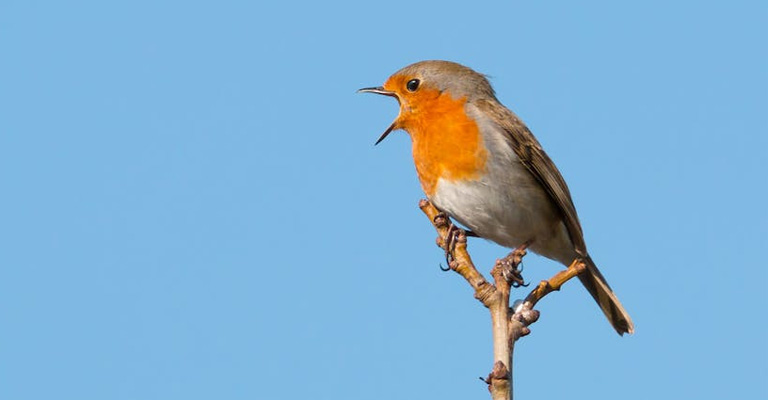Birds are renowned for their melodious songs and vibrant calls that fill the air with a symphony of sounds.
Whether it’s the cheerful chirping of sparrows, the haunting hoots of owls, or the melodious trills of songbirds, the avian world is a constant source of auditory delight.
But have you ever wondered why do birds make so much noise? Beyond their aesthetic appeal, the vocalizations of birds serve a variety of essential purposes.
From attracting mates and defending territories to communicating with their flock and warning of potential dangers, the cacophony of bird sounds is a fascinating aspect of their behavior.
In this article, we will delve into the reasons behind the vocal prowess of birds, exploring the evolutionary, social, and ecological factors that contribute to their diverse and captivating repertoire of sounds.

Why Do Birds Make So Much Noise?
Birds make a variety of noises for several reasons. These sounds serve different purposes, including communication, territorial defense, courtship, and warning signals. Let’s explore these reasons in more detail:
Communication
Birds use vocalizations to communicate with each other. They have a wide range of calls, songs, and chirps that convey different messages.
For instance, they may use specific calls to indicate the presence of food, warn others of danger, or establish their territory. These vocalizations help birds stay connected and coordinate their activities within a group.
Territorial Defense
Birds are highly territorial creatures, and they use vocalizations to defend their territory from intruders. By singing or calling loudly, they assert their presence and warn other birds to stay away.
This behavior is particularly noticeable during the breeding season when birds become more protective of their nesting sites and food sources.
Courtship and Mating
Birds often use elaborate songs and displays to attract mates during the breeding season. Male birds, in particular, showcase their vocal abilities to impress females.
These songs serve as a way to advertise their fitness and genetic quality. The complexity and quality of a male bird’s song can indicate its overall health and ability to provide for offspring, making it an important factor in mate selection.
Warning Signals
Birds also produce loud and distinctive calls to warn others of potential threats. For example, when a predator is nearby, birds may emit alarm calls to alert their flock members.
These calls can vary depending on the type of threat, allowing other birds to identify the specific danger and respond accordingly.
By communicating these warnings, birds increase the chances of survival for themselves and their fellow group members.
Social Bonding
Birds use vocalizations to strengthen social bonds within their groups. For instance, flocking birds often engage in chorus singing, where multiple individuals sing together in a synchronized manner.
This behavior helps establish group cohesion and reinforces social ties among the members. By participating in these vocal displays, birds create a sense of unity and cooperation within their community.
Environmental Factors
Birds’ vocalizations can also be influenced by environmental factors. For example, some species are more vocal during dawn and dusk, known as the “dawn chorus” and “evening chorus,” respectively.
These periods are when birds are most active, and the low light conditions make it easier for their songs to carry over longer distances.
Individual Variation
Each bird species has its own unique vocal repertoire, with variations in pitch, rhythm, and melody. These individual differences allow birds to recognize and distinguish members of their own species from others.
By having distinct vocalizations, birds can communicate more effectively within their species and avoid confusion with other bird species in their environment.
Why Do Bird Species Sound So Different to Each Other?

Bird species sound different from each other due to a combination of genetic, anatomical, and environmental factors. Here are some reasons why bird species have distinct vocalizations:
Genetic Variation
Each bird species has its own unique genetic makeup, which influences the development of their vocalizations.
Genetic differences can affect the structure and function of the vocal organs, such as the syrinx (the avian vocal organ), leading to variations in the sounds produced. These genetic variations contribute to the distinct vocal characteristics of different bird species.
Anatomical Differences
Birds have a wide range of vocal adaptations, including variations in syrinx structure, beak shape, and respiratory system.
These anatomical differences affect the way sound is produced and modified, resulting in species-specific vocalizations.
For example, birds with longer and more complex syrinx structures may produce more elaborate and melodious songs compared to those with simpler syrinx structures.
Cultural Learning
Some bird species, particularly songbirds, learn their vocalizations through cultural transmission. Young birds acquire their songs by imitating the vocalizations of adult birds in their social group.
This cultural learning process leads to regional dialects and variations in songs within a species. As a result, different populations of the same species can have distinct vocalizations.
Environmental Influences
The environment plays a significant role in shaping bird vocalizations. Birds adapt their songs to suit their specific habitats and ecological niches.
Factors such as vegetation density, acoustic properties of the environment, and the presence of other sound sources can influence the structure and frequency of bird vocalizations.
These adaptations help birds communicate effectively within their specific habitats and overcome acoustic challenges.
Species Recognition
Distinct vocalizations allow birds to recognize and distinguish members of their own species from others. This is crucial for mate selection, territorial defense, and social interactions.
By having unique vocalizations, bird species can avoid confusion and ensure accurate communication within their species.
Ecological Interactions
Bird vocalizations can also be influenced by interactions with other species. Some birds mimic the vocalizations of other species as a form of communication or defense mechanism.
This mimicry can lead to the development of complex and diverse vocal repertoires within a species.
Evolutionary Pressure
Natural selection plays a role in shaping bird vocalizations. Vocalizations that are effective in attracting mates, defending territories, or warning of predators are more likely to be passed on to future generations.
Over time, these selective pressures can lead to the development of distinct vocalizations in different bird species.
Why Do Birds Make So Much Noise at Sunrise?

Birds are known for their lively chorus at sunrise, often referred to as the “dawn chorus.” There are several reasons why birds make so much noise during this time:
Optimal Singing Conditions
The early morning hours provide optimal conditions for bird vocalizations. The air is usually calm and less noisy, allowing their songs to carry over longer distances without interference.
The absence of wind and other ambient sounds makes it easier for birds to communicate effectively with their songs.
Territory Establishment
Dawn is a crucial time for birds to establish and defend their territories. By singing loudly and prominently at sunrise, birds assert their presence and communicate the boundaries of their territory to other birds.
This vocal display helps prevent conflicts and reduces the need for physical confrontations.
Attracting Mates
The dawn chorus is also an important part of courtship rituals. Male birds use their songs to attract potential mates and demonstrate their fitness and genetic quality.
By singing at sunrise, when visibility is better and competition is high, males can showcase their vocal abilities to females and increase their chances of successful mating.
Species Recognition
The dawn chorus allows birds to recognize and identify members of their own species. Each bird species has its own unique song, and by singing together in the morning, birds reinforce their species-specific vocalizations.
This helps individuals find suitable mates and maintain social cohesion within their species.
Energy Optimization
Singing at sunrise allows birds to optimize their energy expenditure. By vocalizing during the cooler hours of the morning, birds can conserve energy during the hotter parts of the day when they need to focus on foraging and other activities.
Singing early in the morning also helps birds establish their presence and communicate without expending excessive energy throughout the day.
Increased Activity
Birds tend to be more active during the early morning hours. They are energized after a night of rest and are ready to engage in foraging, territorial defense, and other daily activities.
The dawn chorus serves as a way for birds to synchronize their activities and coordinate their movements within their social groups.
Hormonal Influences
Hormonal changes in birds, particularly during the breeding season, can contribute to the intensity of the dawn chorus. As the sun rises, the increase in light triggers hormonal responses in birds, stimulating their vocalizations.
These hormonal changes can amplify the volume and frequency of bird songs during the early morning hours.
Common Bird Sounds and What Do They Mean?

Birds produce a wide range of sounds, each with its own meaning and purpose. Here are some common bird sounds and their meanings:
Song
Songs are complex and melodious vocalizations primarily produced by male birds during the breeding season. These songs serve multiple purposes, including attracting mates, establishing territory, and signaling fitness.
Each species has its own unique song, allowing individuals to recognize and communicate with members of their own species.
Call
Calls are shorter and simpler vocalizations used for various purposes. They can indicate alarm, warning, contact, or social interaction.
For example, alarm calls are sharp and loud sounds that birds emit when they perceive a potential threat, alerting other birds in the vicinity.
Contact calls are softer and serve to maintain group cohesion or locate other members of the flock.
Chirp
Chirps are brief, high-pitched sounds often associated with small bird species. They can serve as contact calls, indicating the presence and location of other birds. Chirps can also be used during courtship displays or as a form of communication between mates.
Trill
Trills are rapid and continuous series of notes produced by some bird species. They are often associated with excitement, territorial defense, or courtship.
Trills can vary in length, pitch, and rhythm, and are used to convey specific messages within the context of the bird’s behavior.
Whistle
Whistles are clear and melodious sounds produced by certain bird species. They can be used for territorial defense, attracting mates, or as a form of communication within a social group. Whistles are often longer and more musical in nature, with a distinct pitch and tone.
Screech
Screeches are harsh and piercing vocalizations produced by birds such as raptors or owls. These sounds are often associated with aggression, territorial disputes, or defense of nest sites.
Screeches can also serve as warning signals to other birds or as a means of communication between individuals.
Hoot
Hoots are deep and resonant vocalizations commonly associated with owls. These sounds are used for territorial defense, attracting mates, or as a means of communication between individuals.
Hoots can vary in pitch, rhythm, and duration, and are often heard during the nighttime hours.
Coo
Coos are soft and repetitive vocalizations produced by some bird species, such as doves or pigeons.
These sounds are often associated with courtship and mate attraction. Coos are gentle and soothing in nature, serving as a way for birds to communicate their presence and intentions to potential mates.
FAQs
Birds learn their songs through a combination of genetic predisposition and cultural learning. Some species have innate genetic templates for their songs, while others learn their songs by imitating the vocalizations of adult birds in their social group.
Yes, many bird species can recognize and distinguish the songs of other species. This ability is important for various reasons, such as identifying potential threats, locating food sources, or avoiding competition.
While most birds are diurnal and primarily sing during the day, some species are known to sing at night. These nocturnal singers, such as nightingales or mockingbirds, often have specific reasons for singing after dark.
Birds repeat their songs for several reasons. Repetition helps to establish and reinforce their territory, attract mates, and communicate their presence to other birds. By repeating their songs, birds increase their chances of being heard and recognized by potential mates or competitors.
Yes, birds can change their songs over time. This can occur through individual learning, cultural transmission, or evolutionary processes.
Individual birds may modify their songs slightly to match the songs of their neighbors or to adapt to changes in their environment.
Final Words
The remarkable vocal abilities of birds serve a multitude of purposes in their lives. From courtship and territorial defense to communication and survival, their songs and calls are integral to their existence.
By understanding the reasons behind their vocalizations, we gain a deeper appreciation for the intricate world of avian communication.
So, the next time you find yourself surrounded by the delightful cacophony of bird sounds, take a moment to marvel at the complexity and beauty of their melodies.
It is a testament to the rich tapestry of nature and a reminder of the incredible diversity that exists within the avian realm. Embrace the symphony of the birds and let their songs transport you to the enchanting world they inhabit.